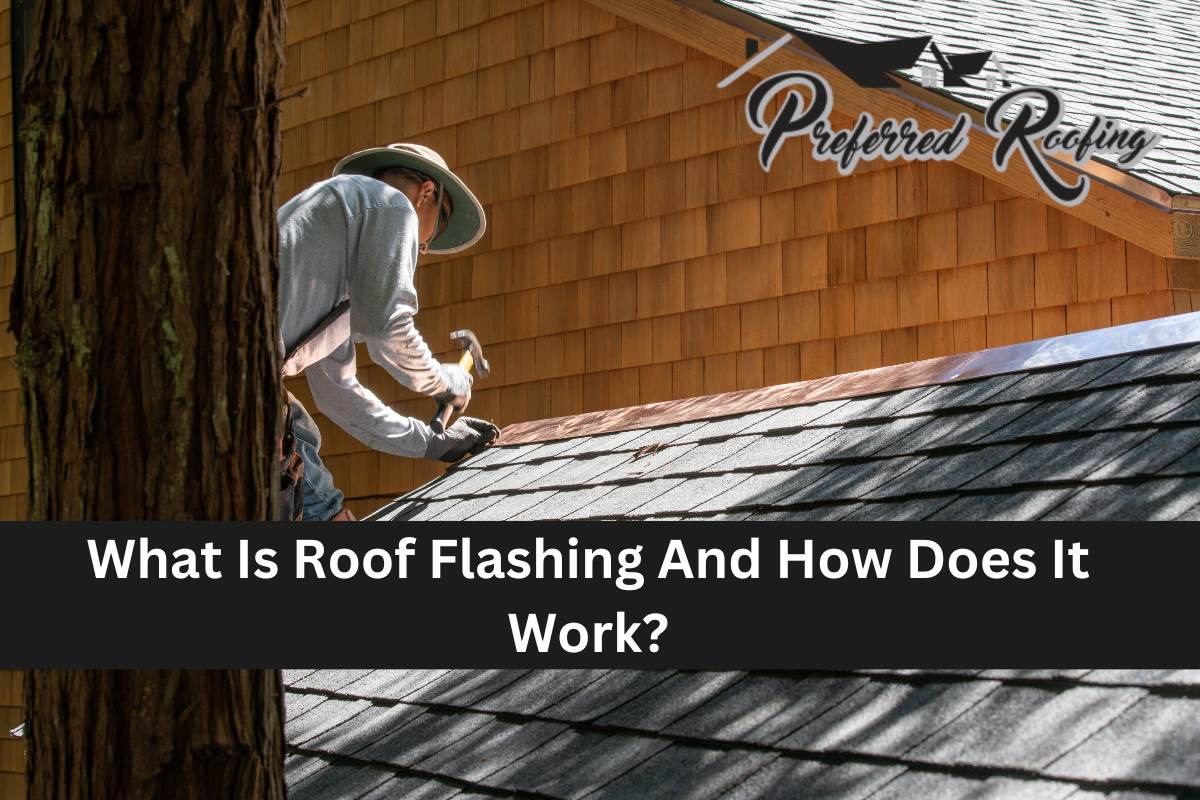Are you building your home’s roof or replacing it? Naturally, you’ll want it to protect your home, prevent leakage, and resist the elements.
And this protection relies on more than your roofing material. For instance, flashing has a part to play in overall roof durability. But what is roof flashing, and how does it work?
What Roof Flashing Truly Is
Roof flashing is the roll of thin metal usually installed over the underlayment and under the shingles in a shingled roof. As for metal roofs, it’s generally on the top of their panels. This metal piece may be copper, lead, galvanized steel, or aluminum roofing that resists moisture and other weather conditions.
The function of this component is waterproofing the protrusions and perimeters of a roof. Roof flashing can prevent water damage, mold, and other forms of damage caused by extreme weather. And it should be professionally installed to function properly and remain intact.
So, you’ll need a professional roofing company like Preferred Roofing. We use the best industry materials made to withstand harsh weather conditions. Contact us now, and you can request a free inspection.
What Roof Flashing Does
Roofs feature joints and seams in vents, valleys, skylights, and more. These joints can permit water into your roof’s construction material. And this is where roof flashing comes in.
Flashing closes these joints and redirects water away from seams and joints, preventing water and moisture damage. Whether the flashing is on a roof or around the house, it collects pooling water and moves it away from the opening.
Where to Install Roof Flashing
If you expect your roof flashing to do its job, you shouldn’t miss any joints, seams, and openings. You’ll need a good contractor to assess the roof’s situation and determine all the places where you’ll need flashing. But here are the main areas most prone to leakage:
Chimneys
You must seal the area around your chimney. Otherwise, it’ll let water into your home’s interior. For chimneys, flashing looks like small, L-shaped metal pieces.
You should install roof flashing between the shingle courses and over the cricket or saddle roof, which is the angled ridge that directs rain away from the chimney stack. There’s also counter flashing mortared into the brick or stone course and over the step flashing. And the flashing mortared into the chimney’s lower front.
Valleys
You’ll need flashing in the meeting points of valleys. These areas are the intersections of two sloping roof planes, and their angles make for a weak point, which is prone to water penetration. Roof flashing should be under the roof shingles at the edges. This way, water can flow away from them into the gutters or down the roof.
Vents
Do you have hood or pipe vents protruding from your roof? Whether they’re plumbing vents, pipes, or others from wood or pellet stoves, you need roof flashing to block any possible water entrances. The roof flashing should also feature a central spout opening to create a water-tight seal.
Skylights
If your roof features skylights, these window-like designs come with raised wood curbs that make room for flashing. Some might even have built-in flashing installed.
Decking
It’s easy to spot the metal frame on the house’s side. It prevents water from pooling behind the wooden barrier that keeps the deck secure.
Types of Roof Flashing
There are plenty of roof flashing types, but the most prominent ones are:
Abutment Flashing
You’ll need flashings for abutments (junctions of roof surfaces with walls or any structural features). That’s because they stop water from slipping between these junctions. You’ll find them in the same color as your tile sheet.
Continuous Flashing
Continuous flashing is also known as apron flashing. And it has earned its nickname by functioning like an apron (water dripping down a long piece of metal to the shingles underneath). Their built-in expansion joints allow them to expand and contract with the change in weather so that the metal board doesn’t warp or break.
Shadowline Barge Board Flashing
Roofers install Shadowline flashings at the end of a run of sheets with the goal of trimming and sealing off the edge of a roof.
Two-Piece Flashing
We’ve referred to chimneys and how they require flashing in several spots. Two-piece flashing contains a base flashing, which is the bottom metal piece, and counter flashing. Together, they catch and move all the rain to accommodate the natural expansion and contraction caused by weather changes.
Step Flashing
Step flashing has a 90-degree angle at the center to fit in the intersection between roofs and walls. The installation of several flashing pieces enables water to slide away from the wall.
Drip Flashing
The thin metal that lines a roof’s edge is drip flashing. It ensures that water drips off the roof without damaging your home or causing leaks.
Ridge Flashing
Do you have an apex roof? This flashing type protects the joint along the ridge by bridging the gap between two roof slopes at the apex.
Final Thoughts
Roof flashing is a metal component that covers up joints, seams, and openings in your roof to avoid water slipping into your roof’s material or the elements, causing any damage. You’ll need them on chimneys, vents, valleys, and more; they each have appropriate flashing types.
But to properly determine where your roof needs flashing and what type of flashing to pick, you’ll need an expert roofer. Our experts will gladly help you with information, installation, and more. Our materials will enable your roof to withstand the elements, so contact Preferred Roofing to protect your investment!





